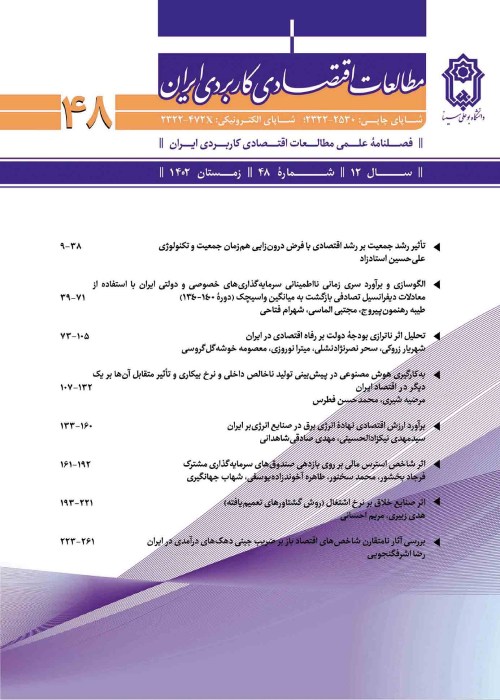Testing the Validity of the Feldstein-Horioka Puzzle in Iran (Considering Lucas Critique)
Author(s):
Article Type:
Research/Original Article (دارای رتبه معتبر)
Abstract:
Goal: Investigating the relationship between saving and investment is one of the major issues in macroeconomics. This issue has drawn increasing attention after FeldsteinHoriokas study (1980). Based on their hypotheses, saving coefficient indicates the degree of international capital mobility. In a way that the fewer obstacles there are for the entry and the exit of capital, the more the aforementioned coefficient decreases. FeldsteinHorioka tested this hypothesis for OECD countries. But unexpectedly the saving coefficient was big. This contradiction which is known as FeldsteinHorioka puzzle, is one of the important puzzles in economics and has the reputation for being the mother of puzzles. After almost four decades, Feldstein--Horioka Puzzle has tested several times and has been open to challenging criticisms. One of the criticisms is ignoring Lucas's critique (1976) which centers around the instability of Pattern Coefficients encountering the policy changes. The present study is to examine Feldstein-Horioka Puzzle by applying Markov switching approach in Iran during the three periods before and after the victory of the Islamic Revolution (1356: 4 - 1339: 4 and 1391: 4 - 1357: 1) and also during 1391-4: 1347: 2. The issue is of noticeable importance for a couple of reasons: Firstly, Feldstein--Horioka Puzzle investigates the dynamics of the current account as an important issue in open macroeconomics and illustrates the relationship between saving and investment. Secondly, it can be used for the evaluation of the degree of international capital mobility.
Methodology
To accomplish this, Markov switching approach has been used. Markov switching approach is one of the most famous non-linear patterns and uses several equations to explain the behavior of the variables in various regimes. By changing the equations in different regimes, the approach makes it possible for the model to explain complicated dynamic patterns. The core feature of the mechanism of regime change in this model depends on a situation variable which follows the characteristics of First order Markov chain. Thats why, the aforementioned approach is used to explain the data that illustrates various behavioral patterns at different times. Results
Based on FeldsteinHorioka hypothesis (1980) Rate of saving rate in Irans economy- as a country with little international capital mobility- is high. The conclusions obtained from Markov switching approach indicated that when the investment in regime is zero (recession), saving coefficient is 0.196 and when the coefficient is 1 (boom), the coefficient is 0.744. When the investment lies in the boom phase, there will be a relatively high coefficient between the saving and investment which implies that Feldstein--Horioka Puzzle does not hold true. As long as the investment has a stagnant state and deteriorates the situation of macroeconomics, the saving coefficient will be high and Feldstein--Horioka Puzzle holds true.Conclusion
Based on the above results, two important conclusions can be drawn: firstly, Feldstein--Horioka coefficient does not provides a proper description in Irans economy. Secondly, with regard to Locus critique, the saving coefficient being low is attributed to the change in the behavior of economic agents as a result of the lack of suitable prospect for investment. Therefore, the policy implications of this research are as follows:First, it is advisable to pay more attention to adopting policies that lead to an increase in domestic savings; Secondly, Enhance the economic and political status to increase foreign direct investment. In this regard, encouraging foreign investors, identifying and introducing investment situations and providing the appropriate framework for attracting foreign capital seems essential. Based on the results of the third period, the boom of investment is fluctuating. Hence, it is necessary to pay more attention to the stability of investment. Keywords:
Language:
Persian
Published:
Quarterly Journal of Applied Economics Studiesin Iran, Volume:6 Issue: 24, 2017
Pages:
1 to 22
magiran.com/p1776425
دانلود و مطالعه متن این مقاله با یکی از روشهای زیر امکان پذیر است:
اشتراک شخصی
با عضویت و پرداخت آنلاین حق اشتراک یکساله به مبلغ 1,390,000ريال میتوانید 70 عنوان مطلب دانلود کنید!
اشتراک سازمانی
به کتابخانه دانشگاه یا محل کار خود پیشنهاد کنید تا اشتراک سازمانی این پایگاه را برای دسترسی نامحدود همه کاربران به متن مطالب تهیه نمایند!
توجه!
- حق عضویت دریافتی صرف حمایت از نشریات عضو و نگهداری، تکمیل و توسعه مگیران میشود.
- پرداخت حق اشتراک و دانلود مقالات اجازه بازنشر آن در سایر رسانههای چاپی و دیجیتال را به کاربر نمیدهد.
In order to view content subscription is required
Personal subscription
Subscribe magiran.com for 70 € euros via PayPal and download 70 articles during a year.
Organization subscription
Please contact us to subscribe your university or library for unlimited access!


